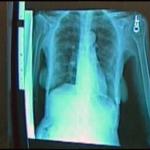July 06, 2011

Photo: VOA
Lung cancer sufferers whose disease was discovered by CT scans, as opposed to x-rays, have a better survival rate, according to a new study from the National Cancer Institute.
A new study has found smokers and former smokers who develop lung cancer are more likely to survive if their disease is detected with a computed tomography, or CT scan instead of a standard chest x-ray, according to a recent study.
That's because a CT scan picks up lung cancer tumors at a much earlier and more treatable stage.
The five-year study, conducted by the US National Cancer Institute, compared conventional, single-image chest x-rays to CT scans in a group of more than 53,000 heavy smokers and former smokers at 33 centers around the United States.
Between 2002 and 2004, researchers enrolled participants - between the ages of 55 and 74 - who either received one chest x-ray per year for three years or got an annual computed tomography scan for three years.
CT scans give radiologists a three-dimensional view of the lung, detecting potentially cancerous nodules as small as a grain of rice.
In December 2009, when investigators followed up, they discovered a 20 percent higher survival rate among those who received CT scans compared to the x-ray group. The reason - the more sensitive computer tomography picked up cancerous lung lesions at a much earlier stage, when they were smaller and easier to treat.
Christine Berg, the study's lead author, is not ready to recommend lung CT screening for all heavy smokers and former smokers.
For one thing, she says, CT scans are known to produce both a high rate of positive results and so-called false positives, which identify lung nodules that might be cancerous but often turn out to be benign.
"The rate of positive testing was 24.2 percent throughout the study on average," says Berg. "That's a high rate and then these individuals need to have a lot of follow-up examinations. And so I think that before one considers embarking on a program of screening, either for an individual or full a health care organization, one needs to look at the full picture."
Claudia Henschke, who heads the Lung and Cardiac Screening Program at Mount Sinai Medical Center in New York, has been conducting her own lung screening program using low-dose CT imaging.
She's found that heavy smokers and former smokers who undergo regular CT scans increase their chances of survival by 90 percent when the cancer is detected early.
"I feel delighted for the people at high risk of lung cancer that there's further confirmation of our results and that hopefully people will avail themselves of that," says Henschke.
Critics have said the benefits of yearly scans have to be weighed against the risk of false positives, unnecessary radiation exposure and potentially risky diagnostic work-ups.
Because of these concerns, Henschke believes it will be some time before there are any official recommendations for lung screening, as there are now for breast or colon cancer.
"I think, in the meantime, there are programs that provide screening and have protocols in place, and then individuals can make up their minds after talking to their physicians as to whether they want to have such a screening test."